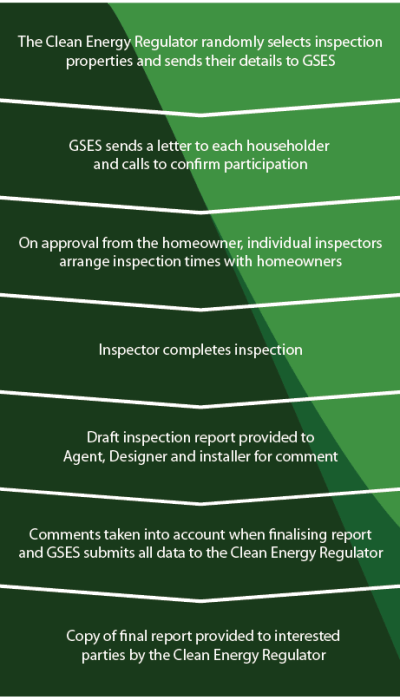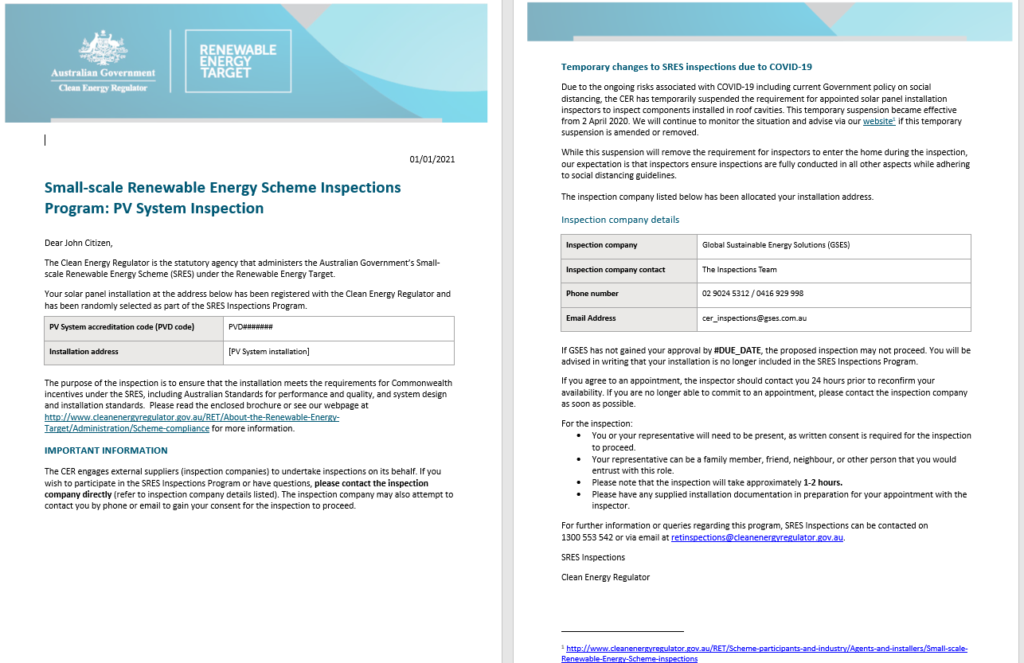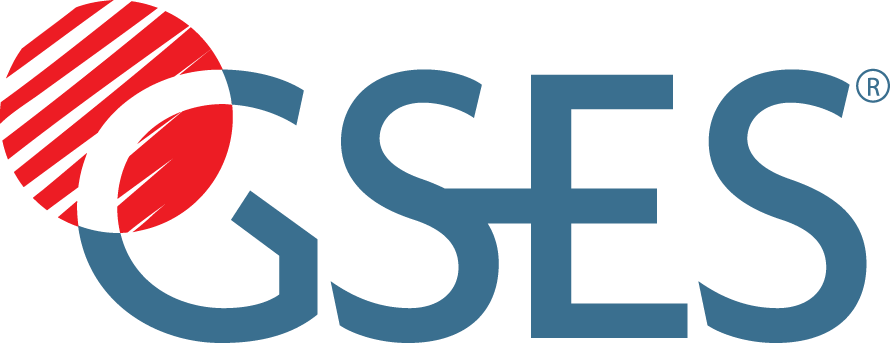Renewable Energy Target Solar Inspections Services
GSES is currently undertaking solar inspections across Australia on behalf of the Clean Energy Regulator. The Renewable Energy Electricity Act 2000 requires inspections on a random selection of solar installations that received Small-scale Technology Certificates (STCs) to ensure they comply with Australian Standards and Industry Regulations. The Clean Energy Regulator is the Government body responsible for this.
GSES is responsible for arranging and completing the inspections, enabling the installers and agents to comment, then submitting the reports to the Clean Energy Regulator. State and Territory Government regulators are responsible for enforcing safety standards and regulating consumer protection.

Have you received a letter or phone call from us?

Read these FAQ’s below:

Renewable Energy Target Solar Inspections Services
GSES is currently undertaking solar inspections across Australia on behalf of the Clean Energy Regulator. The Renewable Energy Electricity Act 2000 requires inspections on a random selection of solar installations that received Small-scale Technology Certificates (STCs) to ensure they comply with Australian Standards and Industry Regulations. The Clean Energy Regulator is the Government body responsible for this.
As an inspection company, GSES is responsible for arranging and completing the inspections, enabling the installers and agents reasonable opportunity for comment, then submitting the final data and comments to the Clean Energy Regulator who generate and send the final report. State and Territory Government regulators are responsible for enforcing safety standards and regulating consumer protection.
Have you received a letter or phone call from us?

Read these FAQ’s below:
Homeowners And Occupiers
What is the Clean Energy Regulator?
The Clean Energy Regulator is the statutory agency that administers the Federal Government’s Small-scale Renewable Energy Scheme. The Office of the Renewable Energy Regulator (ORER) formerly administered the scheme and was amalgamated into the Clean Energy Regulator on 2 April 2012.
The scheme encourages the purchase of solar water heaters, heat pumps, solar panels and small-scale wind, or hydro systems by offering a financial benefit to owners through the creation, assignment and/or sale of small-scale technology certificates (STCs).
The scheme is implemented through the Renewable Energy (Electricity) Act 2000 (the Act) and the accompanying Renewable Energy (Electricity) Regulations 2001 (the Regulations).
The Clean Energy Regulator has the power to enforce compliance requirements as listed under the Act and Regulations.
Text quoted from Clean Energy Regulator information for owners and inspectors factsheet April 2012.
Why is this inspection being conducted?
The Clean Energy Regulator is required under the Renewable Energy (Electricity) Act 2000 to conduct inspections on solar panel installations that have had STCs listed against them in the REC Registry.
Your solar panel installation has therefore been randomly selected from the REC Registry for inspection. The inspectors will complete a comprehensive check of your solar panel installation to ensure that you installation conforms with:
- applicable Australian Standards and industry guidelines as in force at the time the unit was installed,
- State/Territory and local government requirements, and
- the requirements for the creation of certificates.
Text quoted from Clean Energy Regulator information for owners and inspectors factsheet April 2012.
I received a letter or message from GSES, what do I do?
GSES will attempt to contact you in the weeks following the receipt of the letter to obtain consent for the inspection to proceed. Alternatively you can the office 1300 659 282 or email us on cer_inspections@gses.com.au to inform us directly.
I have confirmed an inspection with GSES but the inspector has not called me, what do I do?
As the inspection period is spread over several months, the inspector may take some time to arrange an appointment. The staff member should have noted the time frame within which the inspection should take place. If you are unsure of this time frame call us for confirmation. Under Regulation 37, the inspector is obliged to contact the householder / occupier at least 24 hours before the proposed inspection to confirm the appointment, otherwise entry to the premises may be viewed as without informed consent. When re-confirming the appointment availability with the householder, the Inspector will request the householder to gather any documentation regarding the installation in readiness for the inspection.
What are my rights?
You have the right to:
- Refuse consent for the inspectors to enter your property and conduct the inspection.
- Nominate a representative, such as a family member or friend, to be present for the inspection.
- Ask the inspectors to show you their identity cards.
- Refuse to answer any questions the inspector may ask you related to: the design or installation of the solar panels and the creation of certificates.
- You, or your representative, can observe the inspection while it is being carried out.
- Ask the inspectors to leave your property at any stage during the inspection.
- Be informed of the nature and extent of any imminent safety risk to a person or property caused by the small-scale solar panel, wind or hydro system at the time of inspection.
Text quoted from Clean Energy Regulator information for owners and inspectors factsheet April 2012.
What powers do the inspectors have?
The inspectors have the power to:
- Request consent to conduct an inspection of the solar panel installation on your property.
- Examine and test the solar panels and any wiring or equipment associated with the system.
- Take photographs of anything relevant to the installation.
- Make a video recording of the inspection.
- Access your roof to conduct the inspection.
- Ask you questions related to the design or installation of the solar panels and the creation of certificates.
Text quoted from Clean Energy Regulator information for owners and inspectors factsheet April 2012.
Will I be advised of the inspection outcome?
On completion of the inspection, the inspector must provide a written report to the Clean Energy Regulator. If the report contains an adverse finding in relation to a person who designed or installed the solar panels or who created certificates for the unit, the inspector must provide the findings to those persons for an opportunity to comment before finalising and submitting the report.
The inspector must allow the designer, agent and/or installer a reasonable opportunity to comment on the draft inspection report and take account of any comments provided by the person when finalising the report. A reasonable opportunity has been deemed as a minimum of 14 days unless otherwise negotiated.
During the inspection, if the inspectors consider there may be an imminent safety risk to a person or the property due to the solar panel installation, they must notify all interested parties (the Occupier, the Clean Energy Regulator, the relevant State and Territory Safety Authority and the relevant distribution Network Service Provider) of the extent and nature of any imminent safety risks.
The Clean Energy Regulator will provide a copy of the final report to interested parties under Regulation 44. Interested parties are the owner of the unit, the occupier of the premises, the person who created the certificates for the unit, the designer and installer of the unit and in the event of design and installation issues, the relevant State Regulator and the Clean Energy Council.
Text quoted from Clean Energy Regulator.
What happens if an inspector finds a safety risk?
If during the course of the inspection, the inspector finds that the installation presents an imminent safety risk the inspector will immediately do what is needed to make the installation safe. The inspector will undertake this action under the terms of their electrical licence. This may mean that the inspector disconnects or shuts down the system. The inspector will inform you of the nature and extent of the safety risk on the same day. The inspector will also advise the relevant state or territory regulator for electrical safety of the nature and extent of the safety risk.
The inspector has no authority to rectify faults in the installation during the inspection.
State and Territory government regulators are responsible for safe operation of the installation, particularly electrical safety. If an imminent safety risk is found, on the same day of the inspection, the inspector will contact the State or Territory government regulator and the Clean Energy Regulator to inform them of the nature and extent of the safety risk.
On completion of the inspection, the inspector will prepare a draft inspection report on the inspection that will be sent to the person that created the certificates and the designer and installer. This report will contain more detail on the safety risk and any other non-compliance issues identified during the inspection. These parties are provided the opportunity to make comment on the draft report, and these comments are taken into account when finalising the report.
Dependent on the installation warranty, the installer or related company may return to the installation to rectify the non conformance issues identified in the report.
Text from the Clean Energy Regulator Information for owners and occupiers.
I have not received my report, who do I call?
It will usually take at least six weeks to produce the final report after the inspection has taken place. If you are concerned contact the Clean Energy Regulator.
My system has not been rectified, who do I call?
The installer is your first point of contact and should receive a draft report with inspection outcomes for their right of reply. If the system was found to be unsafe or there was a high-risk issue requiring prompt action you would have been informed by the inspector and the draft report should have been sent to the installer within five working days of the inspection. Otherwise, the draft report may take around ten working days to be received by the appropriate parties. If you are unable to contact your installer you can check the Clean Energy Council’s (CEC’s) list of accredited installers on the CEC Website. If the installation company does not rectify the work or you are dissatisfied with their response, you can consult the CEC Complaints and Disputes guidelines which outlines dispute resolution and advice for if your installation company has gone out of business. You can also contact your state or territory regulator for consumer protection. However, we recommend you wait until after you have received the final report as it includes the inspection results and installer/agent formal response.
- Australian Capital Territory – ACTpla.
- Victoria – Energy Safe Victoria.
- Northern Territory – NT Worksafe.
- New South Wales – Fair Trading – Energy & Utilities Unit, Home Building Service.
- Queensland – Department of Justice and Attorney – General – Electrical Safety Office.
- South Australia – Office of the Technical Regulator, The Department for Manufacturing, Innovation, Trade, Resources and Energy (DMITRE).
- Tasmania – Workplace Standards Tasmania, Department of Justice.
- Western Australia – Department of Commerce, Energy Safety.
For more information see the Clean Energy Regulator’s RET Inspection Information Page.
Agents And Installers
Who will be carrying out these inspections?
Inspections must be carried out by a person or organisation who is independent of the designer/installer and does not have a conflict of interest in relation the small-scale solar panels, wind and/or hydro system being inspected, or administration of matters being inspected.
In accordance with Regulation 33 of the Renewable Energy (Electricity) Regulations 2001 (the Regulations), the Regulator may, in writing, appoint a person to be an inspector if satisfied that the person:
a) is of sufficient maturity, and has had sufficient training, to properly exercise the powers of an inspector,
b) holds an unrestricted license for electrical work under the laws of a State or Territory,
c) has sufficient expertise in matters arising under the Act and Regulations in order to critically examine the requirements in Regulation 39 and to prepare a report under Regulation 42, and
d) is of good repute, having regard to the person’s character, honesty and integrity.
Text quoted from Clean Energy Regulator information for Agent and Installer factsheet April 2012.
What is the Clean Energy Regulator?
The Clean Energy Regulator administers an inspections program for installations of small-scale solar panels, wind and hydro systems that have had renewable energy certificates (RECs) or small-scale technology certificates (STCs) created against them. The Clean Energy Regulator is selecting systems for inspection at random from installations registered in the REC registry. The Office of the Renewable Energy Regulator (ORER) formerly administered the inspections program and was amalgamated into the Clean Energy Regulator on 2 April 2012.
The Renewable Energy (Electricity) Act (the Act) requires that each year a statistically significant selection of small-scale solar panels, wind and hydro systems that were installed during that year must be inspected for conformance with:
- applicable Australian standards and industry guidelines as in force at the time the unit was installed,
- State/Territory and local government requirements, and
- the requirements for the creation of certificates.
Text quoted from Clean Energy Regulator information for Agent and Installer factsheet April 2012.
What if a safety risk is detected during an inspection?
If the inspector considers there may be an imminent safety risk to a person or the property during the inspection, they must notify the following interested parties of the extent and nature of any safety risks at the time of inspection:
- the occupier,
- the Clean Energy Regulator,
- the relevant State or Territory Regulator, and
- the relevant distribution network service provider.
Text quoted from Clean Energy Regulator information for Agent and Installer factsheet April 2012 .
What happens after the inspection?
On completion of each inspection, the inspector must prepare a report. If the report contains an adverse finding in relation to a person/s who designed or installed the system or who created the certificates for the unit, the inspector will provide a draft inspection report to the person/s concerned.
The draft inspection report is provided in the form of a letter to the person/s concerned and allows them the opportunity to provide written comment on the findings. These comments may include advice on how the identified non-compliances will be rectified. In the case of Registered Agents, the comments may include advice on the steps taken to ensure the accuracy of information relied on to create certificates. Comments made within 14 days will be taken into account before finalising the report and providing it to the Clean Energy Regulator.
Under Regulation 47 of the Regulations, the Regulator may declare a person ineligible to design and install small-scale solar panels, wind and hydro systems for 12 months, and may publish this information on the website. Agents who improperly create certificates may face penalties and prosecution under the Act.

Text and image quoted from Clean Energy Regulator information for Agent and Installer factsheet April 2012 .
Who receives a copy of the final report?
The Clean Energy Regulator must provide a copy of the final report to interested parties under Regulation 44. Interested parties are the owner of the unit, the occupier of the premises, the person who created the certificates for the unit and the designer of the unit. A copy of the final report is also provided to the Clean Energy Council and to the relevant State or Territory Regulators responsible for electrical and building safety.
Text quoted from Clean Energy Regulator information for Agent and Installer factsheet April 2012.
Common Issues Identified
DC Circuit Breaker ratings: DC Circuit breaker wiring and sizing has been one of the major issues in the previous rounds of inspections (for published reports, see Clean Energy Regulator website). GSES have thus developed additional educational information to assist installers and designers in this issue.
Isolator enclosures: Another common issue with systems has been water ingress in isolators. Read GSES’s resources on isolator enclosures, IP ratings and mounting procedures.
Understand earthing: Read GSES’s resources on understanding functional earthing and equipotential bonding.
For more information for agents and installers, see the Clean Energy Regulator’s page.
